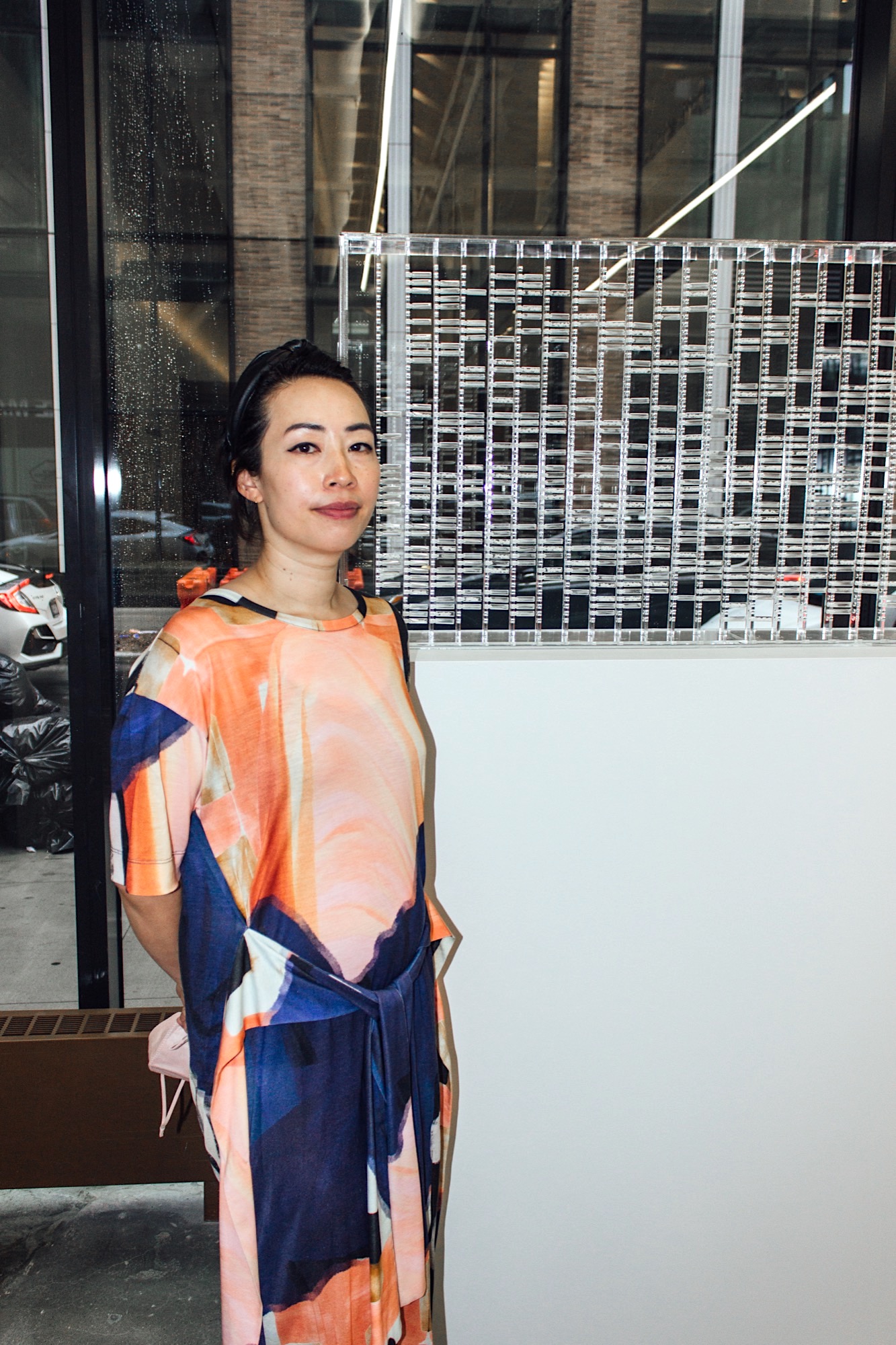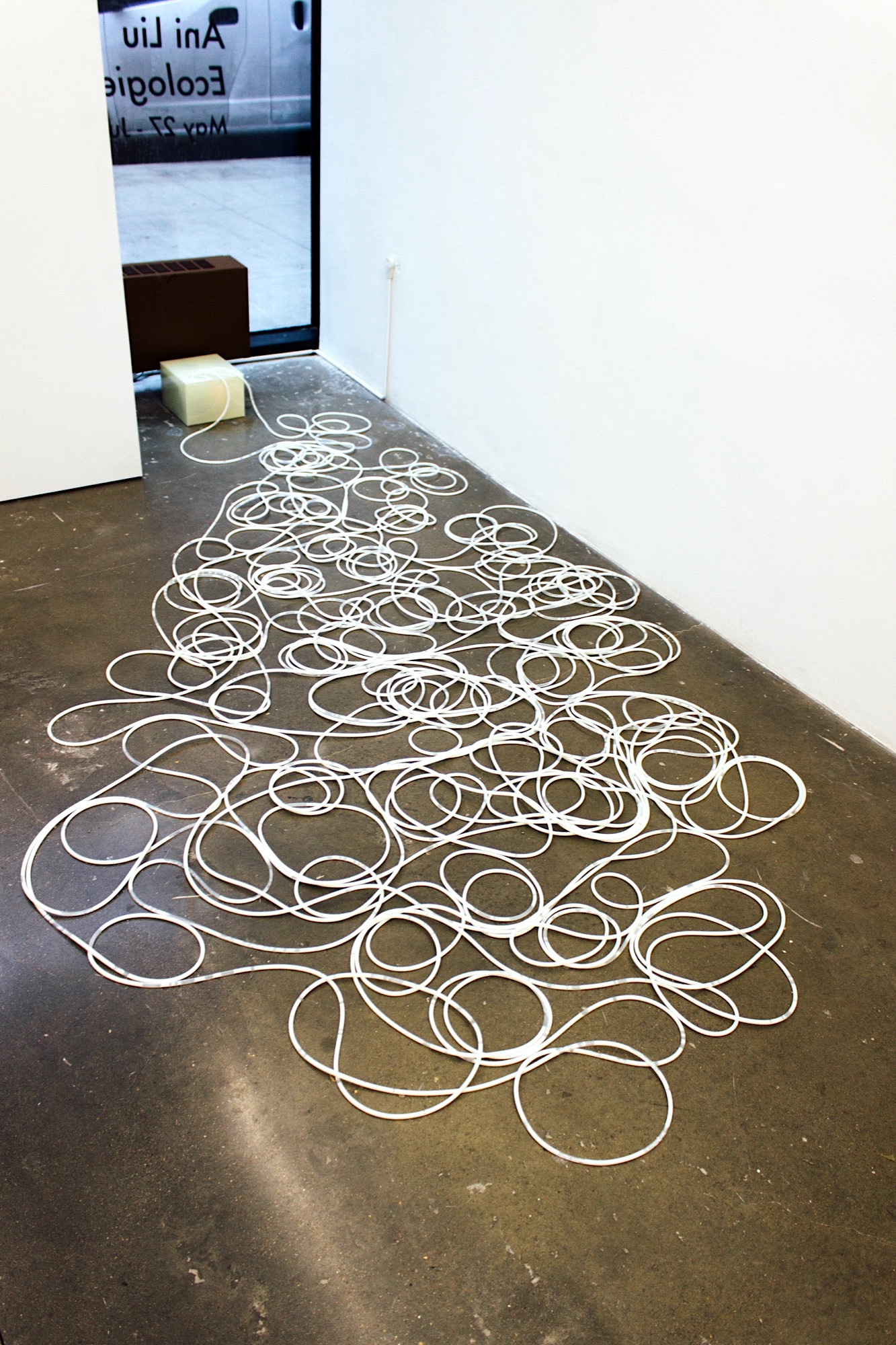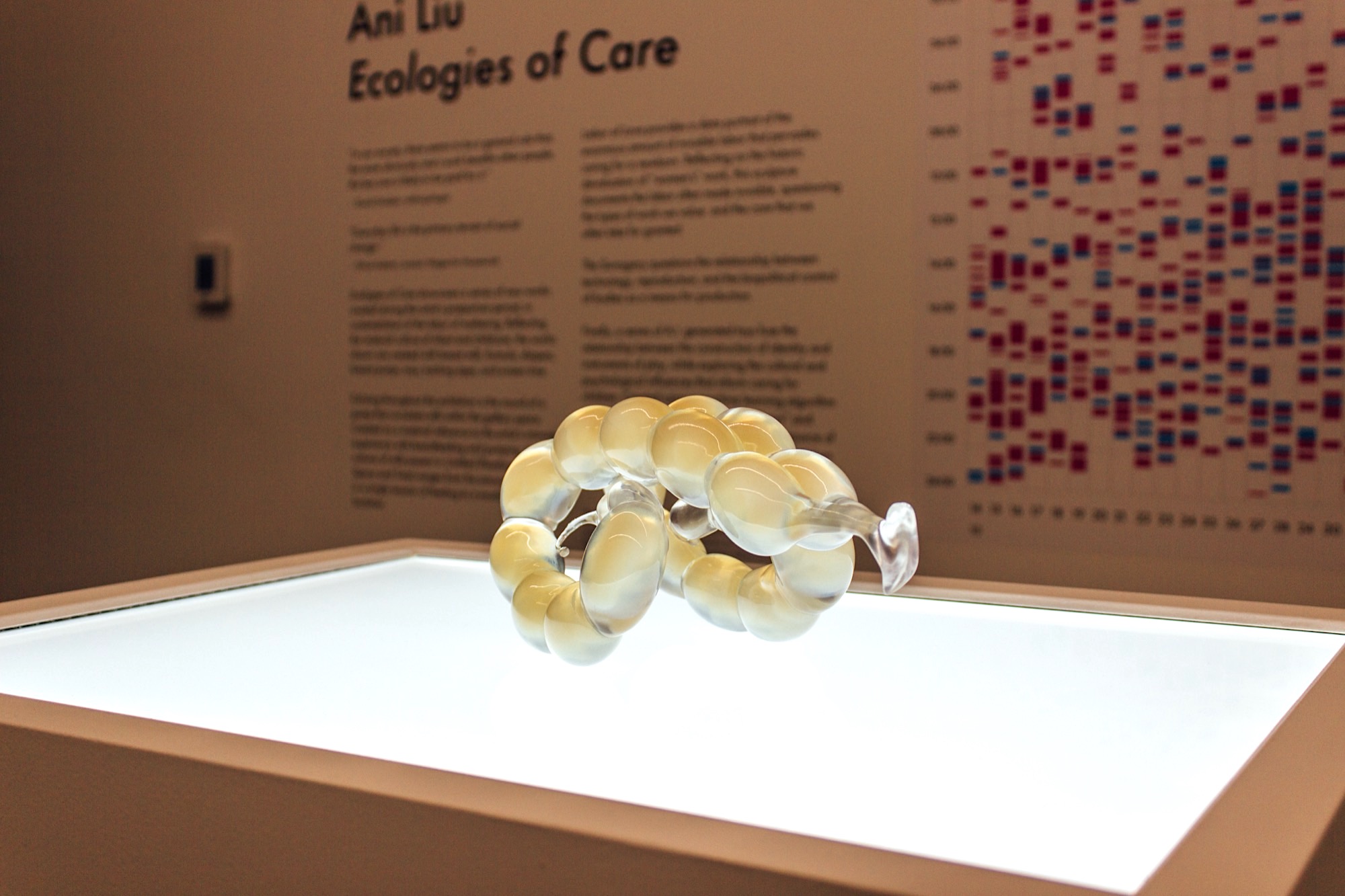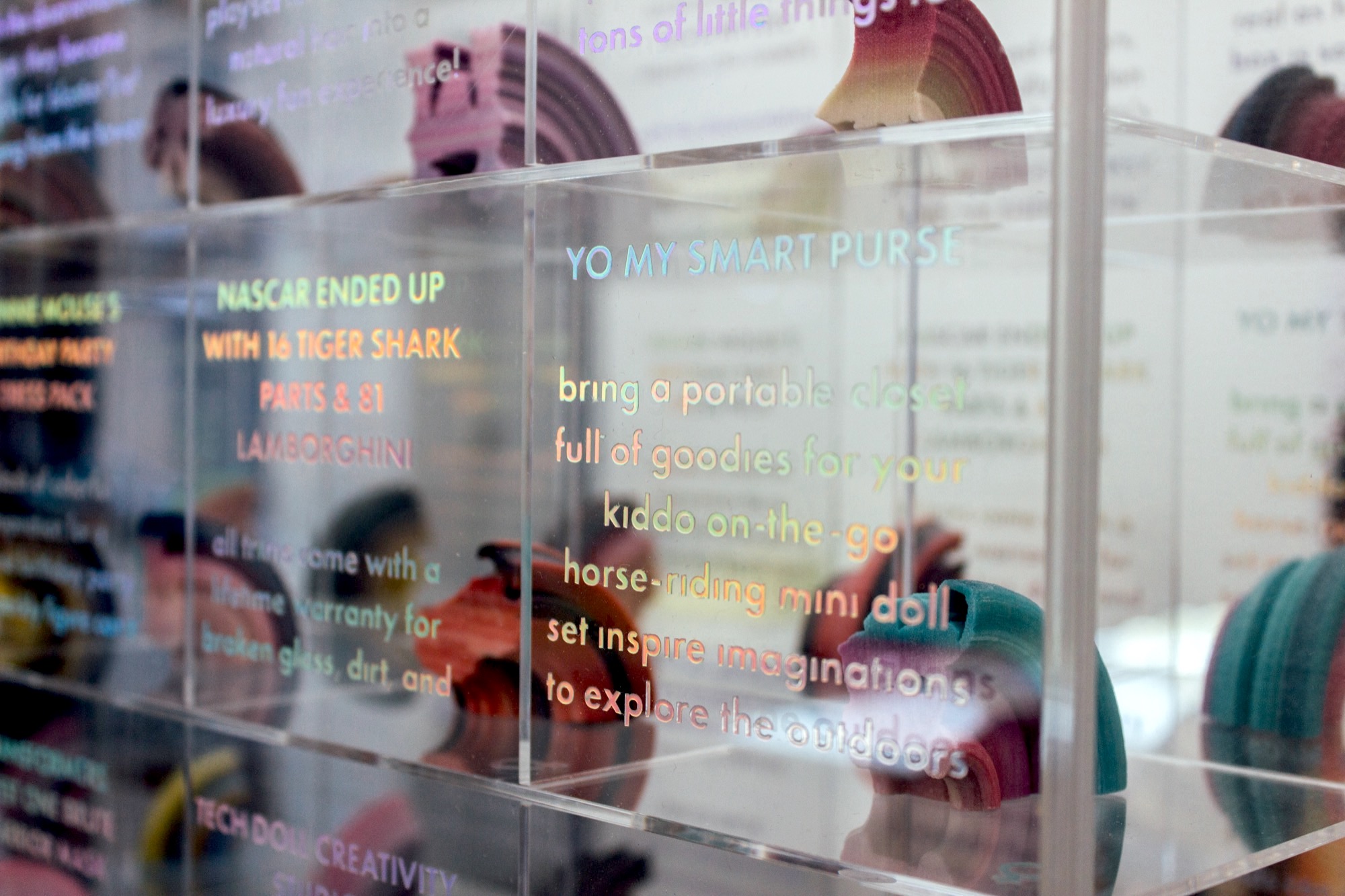Processing Postpartum With AI And Synthetic Breast Milk Art
4:43 minutes

One of Ani Liu’s strengths as an artist is her ability to process emotion through different scientific mediums: machine learning, chemistry, 3D-printing. The result is often visceral: she’s used organic chemistry to concoct perfumes that smell like people emotionally close to her and engineered a device that enables the wearer to control the direction of swimming sperm with their mind.
And at her new exhibition—next to a 3D-printed sculpture of a pig’s uterus—lies 328 feet of clear tubing with a milky-white substance pumped through it, a commentary on pumping breast milk as a new parent. “I wanted to use my own breast milk, but it wouldn’t be stable for the duration of the show,” she said.

Liu became a parent shortly before the pandemic, and she channeled that experience into a new show called “Ecologies of Care,” to process her postpartum period and the communities in her life that helped her through that time.
“I hope that this can allow new parents to bond and maybe feel less lonely,” she said. “In making it, I was questioning how do we create better communities of care? I made all of this work before the formula shortage, before our reproductive rights were even more under threat. When I look at this, I’m hoping that you see this particular slice of love and labor.”
“Ecologies of Care” is on view at the Cuchifritos Gallery + Project Space in New York City until July 30, 2022.


Invest in quality science journalism by making a donation to Science Friday.
Ani Liu is an artist and technology researcher based in Queens, New York.
IRA FLATOW: Artist Ani Liu’s thought-provoking artworks contain anywhere from a dash of science to a whole heaping spoonful of it. She’s used organic chemistry to concoct perfumes that smell like people emotionally close to her and engineered a device that enables the wearer to control with their mind the direction of swimming sperm. Digital audio producer D Peterschmidt visited her latest exhibition in New York and brings us this story.
D PETERSCHMIDT: Ani Liu became a parent right before the pandemic started. And the pieces in her latest show were inspired by her postpartum experience. She gave me a guided tour of some of her work in the gallery and told me about the science she used to make them come to life.
And it all started with her take on a breast pump. Connected to a small, white, opaque box on the floor was 328 feet of clear tubing looped around on top of itself. A white liquid pulsed through the tubes. And the effect was pretty hypnotic.
[MECHANICAL WHIRRING]
ANI LIU: This is a synthetic milk that I designed to mirror the color of my own breast milk. I wanted to use breast milk, but it wouldn’t be stable for the duration of the show. And it was tricky, actually, to kind of create a formula that would have the look of breast milk.
I was trying to capture the rhythm of my breast pump because it was that sound and that rhythm that caused me to let down. Letting down is this mechanism by which your breast will eject milk. And often, that stimulus is your baby’s cute face or the rhythm of their suckle. And I thought that was so interesting. As an artist that works with technology, I was like, wow, my relationship to this technology is almost seamless. Like, I kept thinking about breaking down these boundaries between animal, machine, human.
My breast pump is programmable so that you can find the exact frequency that works for your body. And after I found it, that was, like, the trigger. I needed that particular rhythm. So it’s kind of like [MIMICKING MECHANICAL WHIRRING]
So what you’re seeing here is a 3D print of a pig’s uterus. The pig was chosen because we’ve already genetically engineered pigs to produce organs for transplant. And I was also thinking a lot about the parallels between livestock and women, weirdly, in terms of the exploitation.
Yeah, I made all of this work before the formula shortage, before our reproductive rights were even more under threat. In doing all of this research, I started to think a lot about the biopolitics of why we regulate the reproductive systems of women so much. Like, are we really just factories that make more citizens, more workers, more soldiers, more consumers?
Right after my children were born, I became kind of interested and disturbed by toys, because they were so overtly gendered. And I became interested in toys because I felt like they are almost like little simulations of reality that we want to teach the next generation.
D PETERSCHMIDT: Toy-selling websites like Walmart and Amazon often tag toys as being intended for girls or boys. Liu and a colleague scraped those categories, along with toy names and descriptions, and fed that data to a machine learning algorithm to create new, 3D-printed toys.
ANI LIU: Some of it is kind of quirky. The English is not perfect. So from the girls’ data set, it invented things like, “OMG lights-out unicorn party.” I see one that says, “Yo, my smart purse.”
And from the boys’ data set, it invented things like “brain bolt blaster,” “World War III electronic battling game with single target.” So you can see a lot of the girls’ toys are focused on appearance. There’s lots of makeup kits, lots of princess. And then the boys’ toys are very violent, actually. Tons of weapons, lots of simulations of war.
And so I used the machine learning algorithm kind of like as a mirror to hold up to society, like, oh my gosh, look what we are doing. Look how strange. Look how arbitrary. And is this what we want to continue to perpetuate?
D PETERSCHMIDT: If you’re in New York, you can catch Ani’s exhibition Ecologies of Care at the Cuchifritos Gallery and Project Space from now until July 30. And if you can’t make it, you can see photos and videos of the exhibition at sciencefriday.com/postpartum. For Science Friday, I’m D Peterschmidt.
Copyright © 2022 Science Friday Initiative. All rights reserved. Science Friday transcripts are produced on a tight deadline by 3Play Media. Fidelity to the original aired/published audio or video file might vary, and text might be updated or amended in the future. For the authoritative record of Science Friday’s programming, please visit the original aired/published recording. For terms of use and more information, visit our policies pages at http://www.sciencefriday.com/about/policies/
Dee Peterschmidt is a producer, host of the podcast Universe of Art, and composes music for Science Friday’s podcasts. Their D&D character is a clumsy bard named Chip Chap Chopman.